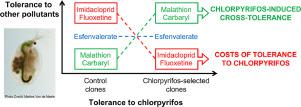Aquatic Toxicology ( IF 4.1 ) Pub Date : 2021-09-23 , DOI: 10.1016/j.aquatox.2021.105980 Marlies Van de Maele 1 , Lizanne Janssens 1 , Robby Stoks 1

|
Exposure to pesticides is a major stressor in freshwater ecosystems. While populations can evolve tolerance to pesticides and thereby ensure their persistence in contaminated environments, this may have important consequences for their sensitivity to other pollutants. Indeed, tolerance to one pollutant may both increase (as a cost of tolerance) or decrease (cross-tolerance) the sensitivity to other pollutants. Despite the increasing concern of pharmaceuticals in waterbodies, no patterns of pesticide-induced (cross-)tolerance have been studied. We conducted 48 h acute toxicity assays with a range of concentrations of different pollutants to determine how the evolution of tolerance to the insecticide chlorpyrifos affects the sensitivity to other pesticides and a pharmaceutical in the water flea Daphnia magna, a keystone zooplankton species in aquatic food webs. We capitalized on an experimental evolution trial with chlorpyrifos, hence could unambiguously identify any patterns in increased tolerance or sensitivity to the other pollutants as a direct result of the evolution of tolerance to chlorpyrifos. We found that evolution of tolerance to chlorpyrifos conferred cross-tolerance to another organophosphate, namely malathion (mean change in EC50,48h: factor 3.1), and to the carbamate carbaryl (factor 1.7), confirming that a shared mode of action favours the evolution of cross-tolerance. While the evolution of tolerance to chlorpyrifos did not affect the sensitivity to the pyrethroid esfenvalerate, it increased the sensitivity to the neonicotinoid imidacloprid as shown by the decrease in EC50,48h (factor 0.6). Notably, we demonstrated for the first time that the evolution of tolerance to a pesticide increased the sensitivity to a pharmaceutical, namely fluoxetine (decrease in EC50,48h with factor 0.7), thereby identifying an overlooked cost of tolerance to a pesticide. Given the increasing exposure to pesticides and pharmaceuticals, our results highlight that considering cross-tolerance and costs of tolerance is crucial in risk assessment of both pesticides and pharmaceuticals in aquatic ecosystems.
中文翻译:

毒死蜱耐受性的进化导致对另一种有机磷酸盐和氨基甲酸酯的交叉耐受性,但降低了对新烟碱类和药物的耐受性
接触农药是淡水生态系统的主要压力源。虽然人群可以进化出对杀虫剂的耐受性,从而确保它们在受污染的环境中持久存在,但这可能会对他们对其他污染物的敏感性产生重要影响。实际上,对一种污染物的耐受性可能会增加(作为耐受性成本)或降低(交叉耐受性)对其他污染物的敏感性。尽管越来越关注水体中的药物,但尚未研究农药引起的(交叉)耐受模式。我们对一系列浓度的不同污染物进行了 48 小时急性毒性试验,以确定对杀虫剂毒死蜱的耐受性的演变如何影响对水蚤Daphnia magna 中其他农药和药物的敏感性,水生食物网中的关键浮游动物物种。我们利用了毒死蜱的实验进化试验,因此可以明确确定对其他污染物的耐受性或敏感性增加的任何模式,作为对毒死蜱耐受性进化的直接结果。我们发现对毒死蜱的耐受性的进化赋予了另一种有机磷,即马拉硫磷(EC 50,48h 的平均变化:因子 3.1)和氨基甲酸甲萘威(因子 1.7)的交叉耐受性,证实了共同的作用模式有利于交叉耐受的演变。虽然对毒死蜱的耐受性的演变不影响对拟除虫菊酯菊酯的敏感性,但它增加了对新烟碱类吡虫啉的敏感性,如 EC 50的降低所示,48小时(系数 0.6)。值得注意的是,我们证明了第一次耐受性农药的演进(在EC减小而增加的敏感性的药物,即氟西汀50,48 ħ用因子0.7),从而识别被忽略的公差成本农药。鉴于农药和药物暴露的增加,我们的结果强调,考虑交叉耐受性和耐受成本对于水生生态系统中农药和药物的风险评估至关重要。











































 京公网安备 11010802027423号
京公网安备 11010802027423号